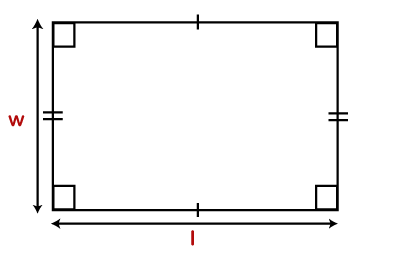We use the Perimeter of a Rectangle Calculator to calculate the rectangle’s outer part by adding its four (two long and two short) sides. Besides giving you the perimeter of the rectangle, the calculator also shows you information about the diagonal length, area, angle between diagonals, and circumcircle radius, all for free.
Take a look other related calculators, such as:
- Phase shift calculator
- 30 60 90 triangle calculator
- 45 45 90 triangle calculator
- Power reducing formula calculator
- Probability calculator 3 events
- Cofunction calculator
- Sum and difference identities calculator
- Trigonometry calculator
- Segment addition postulate calculator
What is a rectangle?
I remember the day when I first come across geometry in high school. It wasn’t very comforting for me at first. I remember I was scared of how many formulas I needed to know and to distinguish different given geometry forms, like a rectangle, cube, circle. All the geometry forms are pretty complex, and you have so many formulas to remember about them.
Let’s look at a rectangle in particular and see how geometry defines it. By definition, a rectangle is a given parallelogram with four sides, two parallel pairs with 90 degrees corners each. The longer side is called the length of the rectangle while the shorter width. It resembles a square a lot by its look, but the square has all sides of equal size.
If you draw a line and connect two opposite corners of a rectangle, you will cross two lines and have one joint. These lines are called diagonals, and they cut the rectangle into two pieces, called triangles. Thus, every rectangle has two diagonals forming a triangle with two corners of 45-degree angle and one of a 90-degree angle.
You can calculate each rectangle’s area, diagonal length, or perimeter through this calculator. In this article, I will be focusing on the rectangle perimeter covering its formula, the process of calculating perimeter, and applying the formula in an example using Perimeter of a Rectangle Calculator. First, of course, we need to narrow down what a rectangle is beforehand.
What’s the perimeter of a rectangle?
The term “perimeter” originates back in the 14th Century, and people first found it in the Greek language. If we consider its given original Greek form, the term “perimeter” consists of two words, peri = around and metros = measure.
If you take all the four sides of a rectangle and make a sum of them with the help of our calculator, you will get a number representing a perimeter of a rectangle. You don’t need to know the diagonal length to calculate the perimeter.
How to find the perimeter of a rectangle?
You can easily measure the perimeter of a rectangle even if you do not have the length of all four sides. From the total four sides, we only need to know the value of two unparallel of them to measure the perimeter of the rectangle. In real-world scenarios, we use the perimeter of a rectangle to measure the distance around a particular shape or object.
The result of the perimeter of the rectangle gives you an overall idea or guidance when you want to build a pool, assumably. Similarly, let’s imagine you are at a construction site and want to build a house. The perimeter calculator results show you constraints or the dimension of the house that you are limited to and should not exceed.
What is a formula for the perimeter of a rectangle?
As we briefly introduced you to the idea of the perimeter, let me show you the actual formula of the perimeter of a rectangle calculator used in math.
P = 2 \times ( length + width)There are two ways to set the formula in math; however, both produce the same result. So, it does not matter which one you choose.

My point is to prove that both given formulas will return the same result. Let’s take a look at the first form of the formula. A rectangle with a length of 10 and a width of 5 would have a perimeter of 30 given by the calculator. How? Let’s see in the formula below.
Perimeter = 2 \times (10 + 5) = 30If we use the same values for the second possible formula, you will have the results as shown below:
Perimeter = 2 \times 10 + 2 \times 5 = 30Same as with a rectangle, there is also a formula for measuring the perimeter of a square or a circle.
How to find the perimeter of a rectangle – example
Let me introduce you to our friend Michael. He is our close friend, and you visit him quite often. However, Michael is in a dilemma and has problems because he wants to fence his house and garden, but he doesn’t know how many fences he needs.

He calls you one day and asks for a piece of advice. He believes you can help him and give him a rough number of the total fences he needs to buy. Now, you are confused and want me to clarify it a bit for you. It makes no sense that I’m associating the perimeter of a rectangle (math) with a guy Michael and his plan to surround his house with fences. At first glance, you are right to think so, but this is a great analogy to explain to you what the perimeter of a rectangle is in a non-math way in the form of a story.
If the area’s width and length around the house are known, we can easily calculate how many fences will be enough to surround the whole garden using the perimeter calculator.
For example, let’s define that the width of the garden is 20 m and the length is 30 m. We will use the Perimeter of a Rectangle Calculator to get the result. This free calculator allows you to calculate using different units such as millimeters, centimeters, meters, kilometers, inches, and more. Not only does it give you the perimeter, but it automatically shows you the diagonal, area, and circumcircle radius of the rectangle.
P = 2 \times (20 + 30) = 100FAQ
What is the area and perimeter of a rectangle?
The area of a rectangle is a number that we get when we do multiplication of the rectangle’s length and width, and it represents the inner part of the rectangle within the perimeter.
The perimeter of a rectangle is a number that we get when we take the number 2 and multiply it with the addition of the length and width of the rectangle. The perimeter of a rectangle is the outer part of the rectangle, excluding the inner part.
How to find the area and perimeter of a rectangle?
The area and perimeter are two different calculations that we can make if we are explicitly talking about a rectangle as a geometry form. Both formulas are pretty simple to use and even memorize. However, the difference comes when we consider the units in which they are calculated. The area of a rectangle is always given in unit square (a number to the power of 2), whereas the perimeter is not.
We get the area of a rectangle by multiplying the length with the rectangle’s width.
Area calculator => O = Length x Width
Different from the area of a rectangle, the perimeter’s formula goes as follows:
Perimeter calculator => P = 2 x (Length + Width)
How to find the perimeter of a rectangle with the area of a rectangle?
If only the area of a rectangle and one of its sides (width or length) is known to us, we can find the perimeter from it. For example, let’s assume the area of a rectangle is 110 m square and the length is 10 m.
A = Length x Width
Width = 11
Now, when we have its width, we can also calculate the perimeter.
P = 2 x (10 + 11)
P = 42
